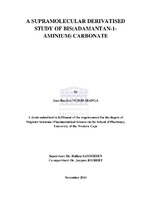| dc.description.abstract | In this study, new solid supramolecular derivatised forms of bis(adamantine-1-aminium) carbonate (ADTCO3) were prepared. ADTCO3 is a derivative of amantadine used for Parkinson’s disease and has antiviral properties against influenza-A, dengue fever and pharmacological activity towards Parkinson’s disease. The new forms prepared were polymorphic and co-crystal forms of ADTCO3. Polymorphism is a phenomenon where the ability of a substance to exist in two or more crystalline forms occurs when crystallised under different conditions and co-crystallization is the process of formation of multicomponent crystals of a drug substance. New solid forms often display different mechanical, physicochemical and thermal properties that can remarkably influence the bioavailability, hygroscopicity and stability of active pharmaceutical ingredients (APIs). For the formation of polymorphs of ADTCO3, techniques such as dry grinding, solvent-drop grinding, co-precipitation, sublimation and vapour diffusion were applied. For the development of co-crystals and/or complex formation, ADTCO3 was treated in combination with ten selected co-formers viz; benzoic acid, 4-hydroxybenzoic acid, cinnamic acid, 4-hydroxycinnamic acid, succinic acid, tartaric acid, salicylic acid, L-glutamic acid, citric acid monohydrate and L-glutaric acid using similar techniques as applied in the polymorphism study. The first four co-formers were selected for their potential biological activity and the latter six were selected for their generally regarded as safe (GRAS) status. All products were isolated and characterized using different analytical techniques to assess the thermal behaviour of the products by hot stage microscopy (HSM), differential scanning calorimetry (DSC) and thermogravimetric analysis (TGA). FTIR spectroscopy and proton-nuclear magnetic resonance (1HNMR) were used to identify and determine the purity of the parent compounds and the modified forms. X-ray powder diffraction was used to determine the formation of a new phase and single crystal X-ray diffraction was applied at the initial stages to identify ADTCO3 by its unit cell parameters. Furthermore, the Cambridge Structural Database (CSD) and other resources were used to generate information on the molecular structures of all elucidated parent compounds, their polymorphs and reported co-crystals. Four different polymorphic forms of ADTCO3 were identified (viz. ADTCO3 Forms I to IV) and sixteen co-crystals (viz. ADTCO3BA1 to ADTCO3BA5, ADTCO3HBA, ADTCO3CIN, ADTCO3HCIN, ADTCO3SUC, ADTCO3LTTA, ADTCO3SA, ADTCO3CA, ADTCO3GLA, ADTCO3GA) were synthesised. Of the sixteen co-crystals 5 were identified as ADTCO3BA “salt” co-crystal polymorphic forms and 2 as ADTCO3SUC co-crystal polymorphic forms. Two solvated “salt” co-crystal forms were also identified, namely; ADTCO3GLA and ADTCO3LTTA. ADTCO3GLA had a mass loss of 10.3% (n = 2.4) and ADTCO3LTTA had a mass loss of 5.25% (n = 0.86). Finally, the rest of the co-crystals ADTCO3HBA, ADTCO3CIN, ADTCO3HCIN, ADTCO3SA, ADTCO3CA and ADTCO3GA all crystallised as “salt” co-crystals. | en_US |

